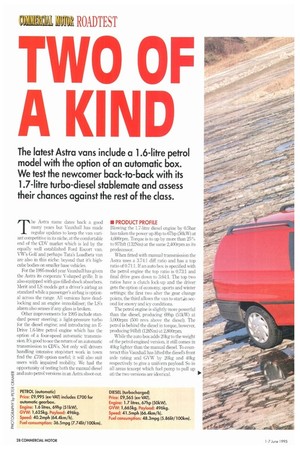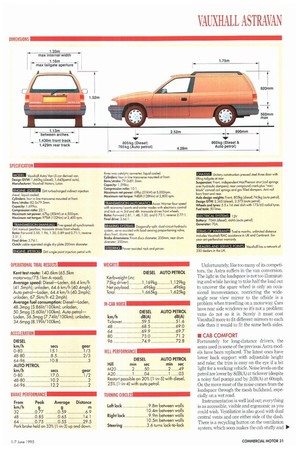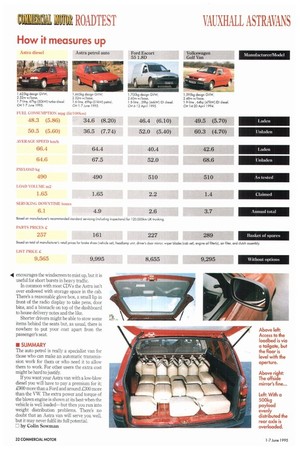TWO OF A KIND
Page 30

Page 32

Page 33

Page 34

If you've noticed an error in this article please click here to report it so we can fix it.
The latest Astra vans include a 1.6-litre petrol model with the option of an automatic box. We test the newcomer back-to-back with its 1.7-litre turbo-diesel stablemate and assess their chances against the rest of the class.
T:te Astra name dates back a good many years but Vauxhall has made regular updates to keep the van variant competitive in its niche, at the comfortable end of the CDV market which is led by the equally well established Ford Escort van. VW's Golf and perhaps Tata's Loadbeta van are also in this niche: beyond that it's high. cube bodies on smaller base vehicles.
For the 1995 model year Vauxhall has given the Astra its corporate V-shaped grille. It is also equipped with gas-filled shock absorbers. Merit and IS models get a driver's airbag as standard while a passenger's airbag is optional across the range. All versions have deadlocking and an engine immobiliser; the IS's alarm also senses if any glass is broken.
Other improvements for 1995 include standard power steering: a light-pressure turbo for the diesel engine; and introducing an EDrive 1.6-litre petrol engine which has the option of a four-speed automatic transmission. It's good to see the return of an automatic transmission to CDVs. Not only will drivers handling intensive stop/start work in town find the .C700 option useful; it will also suit users with impaired mobility. We had the opportunity of testing both the manual diesel and auto petrol versions in an Astra shoot-out. • PRODUCT PROFILE Blowing the 1.7-litre diesel engine by 0.5bar has taken the power up 81ip to 67hp (50kW) at 4,600rpm. Torque is to up by more than 25% to 971bft (132Ntn) at the same 2,400rpm as its predecessor.
When fitted with manual transmission the Astra uses a 3.74:1 diff ratio and has a top ratio of 0.71:1. If an auto box is specified with the petrol engine the top ratio is 0.73:1 and final drive goes down to 3.64:1. The top two ratios have a clutch lock-up and the driver gets the option of economy, sports and winter settings: the first two alter the gear change points, the third allows the van to start in second for snowy and icy conditions.
The petrol engine is slightly more powerful than the diesel, producing 69hp (51kW) at 5,000rpm (500 revs above the diesel). The petrol is behind the diesel in torque, however, producing 941bft (128Nni) at 2,80O-pm.
While the auto box adds 20kg to the weight of the petrol-engined version, it still comes in 40kg lighter than the manual diesel. To counteract this Vauxhall has lifted the diesel's front axle rating and G VW by 20kg and 40kg respectively to give a uniform payload. So in all areas (except which fuel pump to pull up at) the two versions are identical.
• PRODUCTIVITY
Round our Kent test route the diesel-powered Astra returned over 48mpg (5.861it/100km) when laden, which puts it a mouthful ahead of the Ford Escort but a sip behind VIVs Golf. Strangely enough when unladen both the competitors do better than the Astra which sees only a marginal improvement to 50.5mpg (5.601it/100km). Average speed was good (laden was faster than unladen) but this is more a reflection of prevailing traffic conditions and roadworks on the A and M 25.
Not surprisingly, economy wasn't as good with the automatic petrol version, which returned 34.6mpg (8.2 litJ100km) when laden. However, when we last tested its 1.4-litre predecPssor with the five-speed manual transmission, it returned 34.1mpg (8271it/100km) so the slush box isn't damaging the fuel figures to any great degree—and progress is being made.
In the load volume stakes the Escort makes the pace at 2.2m3 leaving the Astra trailing at 1.65m3, not that far ahead of the Golf at 1.4mj (although the companies use different calculating methods). Access to the Astra's load space is via a tailgate but at least the floor is level with the door aperture, which is not the case with the VW Having put the Astra's load in, there's a half-height solid bulkhead with a mesh upper part and six tie-down points to prevent it joining the driver.
The problem is that the driver and loadspace are too far back (or the axles are too far forward). Working on Vauxhall's figures there is more loadspace behind the rear axle than in front, This means that the centre of gravity of an evenly distributed load is about 15mm behind the rear axle. Loading it (evenly) to GVW adds about 60kg to the front axle while putting a driver in only adds another 20kg. Everything else goes on the back and, regrettably, Vauxhall has dropped the evenly distributed load figure from its literature. In order to test the vehicle at its GVVI/ we had to resort to loading some of our test weights in the passenger's footwell, When it comes to getting things moving the manual diesel is quick. It gets to 80km/h almost two seconds quicker than the auto petrol and has an even greater advantage over the laden Escort diesel. Once on the move the diesel Astra's extra torque retains its advantage in acceleration times. Track testing not only showed the competence of the braking system but also the shortcomings of the automatic's speedo: it was 15% out at 30mph with the error reducing to 8% at 60mph.
Both diesel and petrol versions have 14,500km (9,000 miles) service intervals but the diesel requires an intermediate oil change every 7,200km (4,500 miles). There is little excuse for this with modern diesel oils. Vauxhall also specifies an annual 0.7-hour high-mileage service for vehicles covering more than 28,000km (18,000 miles) a year. Based on our 50,000km (31,250 miles) annual service, this gives the diesel Astra 6.1 hours per year in the workshop; the petrol has 4.9 hours. Neither figure compares too well with the VW's 3.7 hours, let alone the Fords frugal 2.6 hours. As the automatic has no clutch it fared well in parts prices, its basket of spares costing £161. The diesel came in at £257, midway between the other two contenders,
• ON THE Sport and Ice settings. ROAD
From the driving seat the Astra is as well laid out as you would expect, of a van that rides on the back of a multi-million-pound car development budget. The gas shock absorbers give the Astra a good ride, loaded or not. Handling is competent provided you don't overload the rear axle (when you get a degree of rear-steer).
Overloads apart, you have to try extremely hard to make the Astra do something untoward. To avoid potential problems in winter there is even an ice warning on the dash. Power steering is definitely a plus— especially as it is a standard fitting across the range and not a £350 option as with Ford's diesel versions. Unfortunately, like too many of its competitors, the Astra suffers in the van conversion. The light in the loadspace is not too illuminating and while having to take half the load out to uncover the spare wheel is only an occasional inconvenience, restricting the wideangle rear view mirror to the offside is a problem when travelling on a motorway Cars have rear side windows so it's not a problem: vans do not so it is. Surely it must cost Vauxhall more to fit different mirrors to each side than it would to fit the same both sides.
• CAB COMFORT Fortunately for long-distance drivers, the seats used in some of the previous Astra models have been replaced. The latest ones have lower back support with adjustable height and rake; the trim is easy on the eye if a bit light for a working vehicle. Noise levels on the petrol are lower by 8cIB(A) at tickover (despite a noisy fuel pump) and by 2dB(A) at 60mph. On the move most of the noise comes from the loadspace through the mesh bulkhead, especially on a wet road.
Instrumentation is well laid out; everything is as accessible, visible and ergonomic as you could wish. Ventilation is also good with dual central vents and one either side of the dash. There is a recycling button on the ventilation system, which soon makes the cab stuffy and ■
1 encourages the windscreen to mist up, but it is useful for short bursts in heavy traffic.
In common with most CDVs the Astra isn't over endowed with storage space in the cab, There's a reasonable glove box, a small lip in front of the radio display to take pens, door bins, and a binnacle on top of the dashboard to house delivery notes and the like.
Shorter drivers might be able to stow some items behind the seats but, as usual, there is nowhere to put your coat apart from the passenger's seat.
• SUMMARY
The auto petrol is really a specialist van for those who can make an automatic transmission work for them or who need it to allow them to work. For other users the extra cost might be hard to justify.
If you want your Astra van with a low-blow diesel you will have to pay a premium for it; £900 more than a Ford and around £300 more than the VW. The extra power and torque of the blown engine is shown at its best when the vehicle is well loaded—but then you run into weight distribution problems. There's no doubt that an Astra van will serve you well, but it may never fulfil its full potential.
0 by Colin Sowtnan








































































































